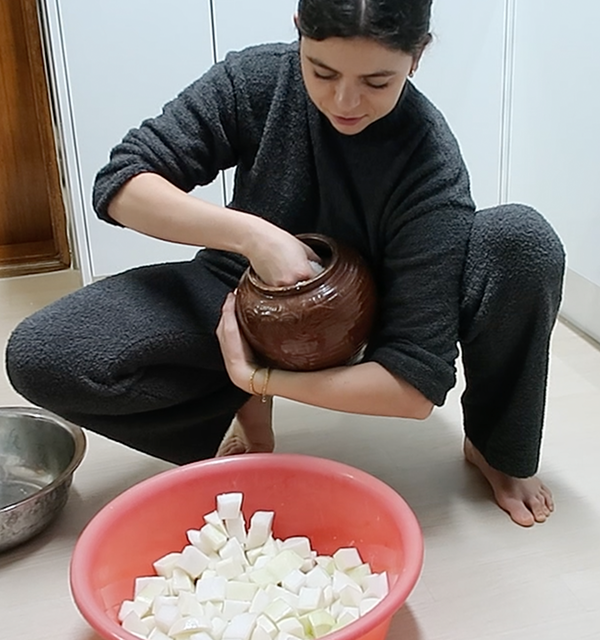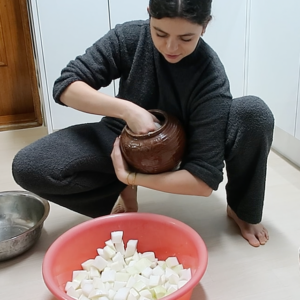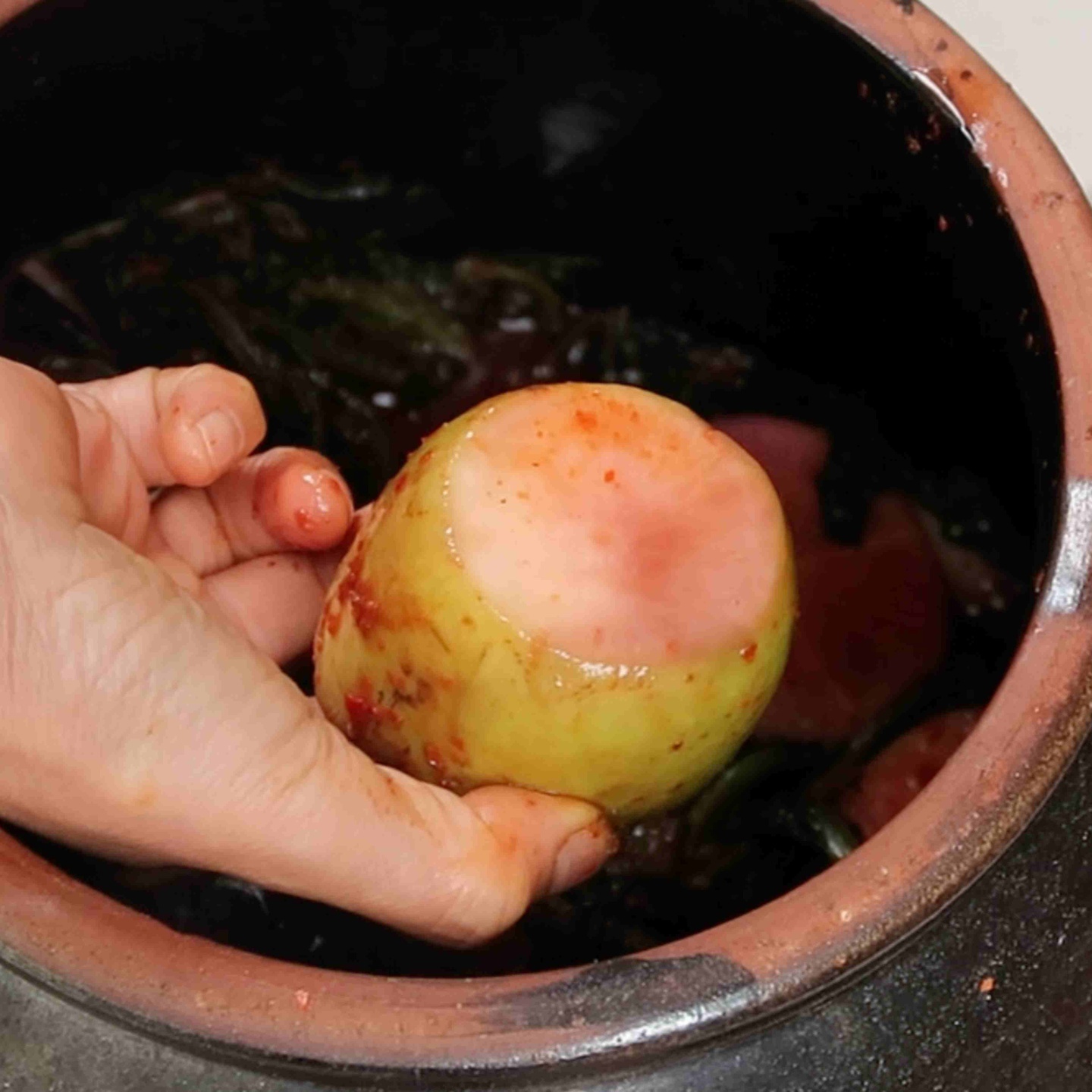Step #3: Making the Seasoning Paste
Now that the cabbage has been prepped and is brining or has been brined. We can make the seasoning paste. A tip is to make this while the cabbage is brining so you can utilize your time better.
How chili peppers changed kimchi
As you know kimchi did not always contain red pepper flakes. Red chili peppers were introduced to Korea and in 1766 the first record that red pepper powder was added to kimchi was made. It could have been before that but this is the first record of it.
Red chili peppers added flavor, color, and spice. The spiciness from the peppers triggers the appetite of anyone near it. Interestingly enough though red pepper flakes actually work to prevent bacteria growth which made red kimchi have less lactic acid in comparison to water/white kimchi which does not contain red pepper flakes.
The red chili peppers used for making red pepper flakes are called “홍고추” in Korean. They are sun-dried and ground into a powder in both a fine and coarse variety. You can use both coarse and fine red pepper flakes when making kimchi but coarse red pepper flakes have a cleaner flavor and gives a good pepper look to your kimchi.
When buying red pepper flakes, try to buy the sun-dried version “태양초”. Using sun-dried chili flakes makes the kimchi stay the same bright red color over a long period of time. You may also see whole dried chili that is then soaked in water and blended and then added to make kimchi. There are different methods and recipes that you may see when chili is added to kimchi.
Vegetables you can use in kimchi
There are variety of vegetables that you can add to kimchi to add extra flavor, color, and umami.
Korean Radish (무/ mu)
Korean radish can be added to kimchi for flavor and texture. It can be added sliced into thin strips, quartered or ground/blended into a paste.
Depending on the kind of kimchi you are making it may be better to remove or keep the outer peel/skin of the radish.
If you are making a fresher kimchi or kimchi that won’t be stored/fermented for too long, than removing the skin of the radish can prevent any tough or fibrous bites of kimchi.
If you are making kimchi that you plan to ferment for a longer period of time you can keep the skin of the radish on so that the structure of the radish is maintained over the longer period of time.
An extra flavor tip for adding radish to kimchi is to soak your sliced pieces of radish in fish sauce for at least 15 minutes or while you prepare the other ingredients for the seasoning paste. You want to soak the radish until you can bend it without it breaking. The reason we do this extra step is to give the radish and ultimately the kimchi a deeper refreshing flavor. You can use the amount of fish sauce that is shown in the recipe that you are using to soak the radish, then just drain it and use the fish sauce and prepped radish in the recipe like usual.
Garlic (마늘/ ma-neul)
Garlic is a necessary ingredient to add to kimchi. Usually, it is minced or blended into a paste and added to the seasoning mixture.
Ginger (생강)
Minced ginger adds a tangy fresh spice to the seasoning paste. You can add ginger minced or blended into a paste. Keep in mind if you are experimenting with your own kimchi recipe that you want to add less ginger in comparison to garlic so not to overpower the flavor of the seasoning paste.
Mustard green (갓, 홍갓/ gat/ hong-gat)
Mustard greens are commonly added to kimchi to add color and a mustardy peppery flavor. Before adding the fresh mustard leaves to the kimchi, cut them into 1-2 inch pieces. There are different varieties of mustard leaf that you can add to your kimchi but red mustard leaf is best to add in red pepper flake kimchi.
Seaweed (청각, 미역/ chong-gak, mi-yok)
Seaweed can add a salty flavor and umami to kimchi. It can be added to vegetarian or vegan kimchi to add that depth and sea flavor.
There are different kinds of seaweed that you can add to your kimchi.
When adding dried sea staghorn (청각), prep it first by soaking it in water and then massaging the seaweed until the water is clean. After trim any hard ends from the seaweed and it is ready to add.
When adding dried sea mustard, you need to soak it first in cold water for at least 30 minutes and slice into pieces before adding. Using sea mustard in kimchi is not very common but it can be a great option for vegan and vegetarians who want to add sea flavor to kimchi.
Green onion (파, 쪽파/ pa, jjok-pa)
Green onion adds important color and flavor to kimchi. Usually the smaller more delicate green onions (파, 쪽파) are added to the kimchi vegetable mix. Larger green onion like 대파 are usually not added to vegetables mixes for kimchi like cabbage kimchi but they can be used alone and made into a green onion kimchi.
Before you add your green onion, cut them into 1-2 inch pieces. You also want to cut any large bulbs or too thick stems in half before adding them.
Water dropwort (미나리/ mi-na-ri)
Water dropwort has a unique celery like smell and can add more flavor, color, and aroma to your kimchi. You can slice the stems and leaves into 1-2 inch pieces and add them to the vegetable mix.
Carrots (당근/ dang-geun)
Carrots can add more color and flavor to kimchi. Peel and thinly slice your carrots with a knife or mandoline.
Garlic Chives (부추/ bu-chu)
Chives are another way to add color and flavor to kimchi. Before adding them to the kimchi cut them into 1-2 inch pieces.
Radish greens (무청/ mu-chong)
You can utilize your tender radish greens by cutting them into 1-2 inch pieces and adding them to your kimchi for color and flavor.
Onion (양파/ yang-pa)
Onion can be added sliced, grated or blended. You can add grated onion to your radish to remove any bitter flavor in the kimchi. When your kimchi is made too salty, add blended or grated radish or onion to dilute and balance the saltiness.
Glutinous rice flour (찹쌀가루)
If you know how red cabbage kimchi is usually made than you know a rice flour paste is added to the seasoning paste. You may wonder if this is an important or necessary step so I will share why this paste is so important to add to your seasoning paste.
The rice flour paste makes the seasoning paste have a thicker texture. It also helps to ensure that the seasoning paste will stick better to the brined cabbage leaves. Finally, this paste is important because it helps to feed the good bacteria that is needed for fermentation.
You need to use glutinous rice flour (찹쌀가루) when you are making your rice flour paste. It is made from glutinous rice which has more starch than regular rice and therefore makes a better thicker rice flour paste.
How to Make the Rice Flour Paste:
- To make this paste, you need to heat it on the stove. First, add the liquid to the pot and then put in the rice flour. Adding the flour to the liquid helps to avoid clumps.
- Next, you must turn the pan onto low heat and whisk the mixture together. Watch and stir the mixture as it cooks, or it will stick. When it’s done, it will look like a thick slurry glaze; try not to make it too thick.
- A tip during this process is to add the red pepper flakes to this hot rice flour paste. Adding the flakes to the heat can help to enhance the flavor, bring out the red pepper aroma and enhance the color of the red pepper flakes. This also makes the ingredients mix well together. After adding the red pepper flakes, you should let the paste completely cool before mixing any other ingredients into the paste.
So, what can you do if you don’t have rice flour? Don’t worry I am going to share some possible substitutes that you can use.
The first substitute is using cooked rice:
If you don’t have glutinous rice flour than you can use cooked glutinous rice (찹쌀밥)
The way you would do that is to add the cooked glutinous rice to liquid and blend it together to make a paste. Using cooked rice is not necessarily better than using rice flour it is just easier.
The second substitute is wheat flour (밀가루).
You would cook and prepare this wheat flour in the same way that you would prepare the glutinous rice flour.
The final important point that I want to mention about making a rice flour paste is the liquid that you can use. You can use any liquid to make the rice flour paste. Some options include a bone broth, seafood broth, seaweed broth or just plain water. Using a broth can help to give your kimchi a deeper flavor but if you do not have any use water.
Adding fresh & salted seafood
You can add seafood to your kimchi, either fresh, salted or both. If the kimchi tastes bland because there was not enough salt used to brine the kimchi then add fish sauce or salted seafood to enhance the flavor.
You may wonder how it is safe to add raw seafood to kimchi when raw seafood goes bad so quickly under normal circumstances.
Well kimchi contains two kinds of lactic acid bacteria. These produce phenyl lactic acid which is antibacterial. This prevents the bacteria that gives us food poisoning from forming. That is why raw seafood is safe to add to kimchi. Also, as we know salt is used for preservation, this also helps make it safe to add raw seafood to kimchi. Remember that proper fermentation and storage are big factors to safely fermenting. Properly fermenting also ensures that these two kinds of lactic acid even form so that it is safe to eat kimchi with raw seafood inside.
Fresh Seafood:
Some fresh seafood that you can add to kimchi are shrimp, squid, oyster, abalone, and octopus. Usually, the seafood is chopped into medium sizes pieces before they are added to the kimchi for easy eating. A tip for when you add seafood to kimchi is to toss them in some red pepper flakes. This can help to lessen the seafoods natural odors and add an extra layer of bad bacteria prevention.
Fish Sauce:
Fish sauce is very important to add for the base flavor of kimchi. My mother in law recommends Sand lance Fish sauce (까나리액젓/ kka-na-ri-aek-jjot) which adds a clean and light umami flavor in comparison to anchovy fish sauce. You can use anchovy fish sauce (멸치액젓/ myol-chi-aek-jjot) if you do not have sand lance fish sauce.
Salted Seafood/Jeot (젓/ jot):
Salted seafood aka jeot is also optional to add to kimchi. You can add different kinds of jeot to kimchi, the most popular is shrimp (새우/sae-u-jot.) Adding salted seafood will deepen the kimchi flavor as it ferments and also speed up fermentation time.
There are different ways to prepare your salted seafood before you add it to kimchi.
Some people prefer to ash their salted seafood under cold water using a sieve before adding it to the kimchi to give the kimchi a fresher flavor.
Some people prefer to strain the liquid from the salted seafood and only add the salted seafood pieces so that they have more control over the saltly flavor that they are adding to the kimchi.
Some people add the salted seafood whole, blended, or chopped into smaller pieces. If you decide to blend your salted seafood keep in mind that the seafood will melt/dissolve after a few days of fermenting.
Adding sweetness to kimchi
Sugar is added to kimchi for a few reasons. Sugar balances any bitter flavor in kimchi, adds flavor, and feeds the microbes that are necessary for fermentation.
Different Sweeteners for Kimchi:
There are a variety of sweeteners that you can use.
- You can add grated apple or pear for natural sweetness and fresh flavor.
- Green plum syrup (매실청/mae-sil-chong) is a sweet light syrup that adds a unique aspect.
- Honey is naturally antibacterial and naturally preserved. It adds a lighter and unique taste.
- White sugar adds a clean flavor without changing the color.
- Pear syrup (배즙/ bae-jeup) which is made from asian pears and acts like a light syrup is also an option.



